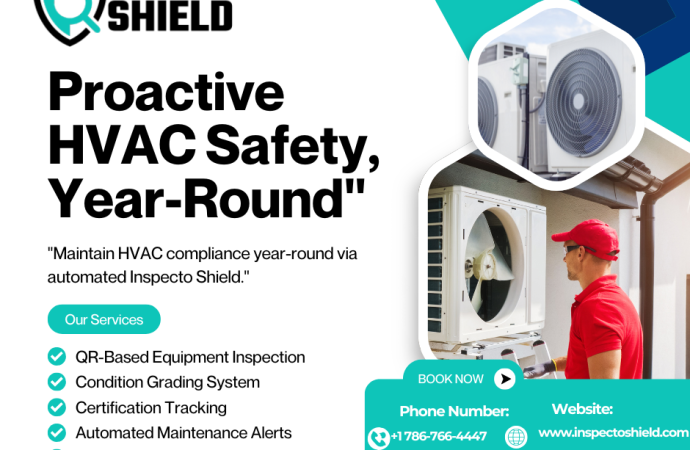Introduction In contemporary healthcare, medical devices are the pillar of patient diagnosis, treatment, and monitoring. Ranging from MRI equipment to infusion pumps, these machines need to work perfectly to provide safety for patients and quality healthcare. However, the conventional inspection and maintenance processes using paper-based logs, manual checks, and reactive repairs no longer suffice in
Introduction
In contemporary healthcare, medical devices are the pillar of patient diagnosis, treatment, and monitoring. Ranging from MRI equipment to infusion pumps, these machines need to work perfectly to provide safety for patients and quality healthcare. However, the conventional inspection and maintenance processes using paper-based logs, manual checks, and reactive repairs no longer suffice in today’s rapidly advancing medical settings.
InspectoShield is a fully digital solution created to transform the management of medical equipment. This 1500-word piece discusses how our cutting-edge platform resolves the special issues of healthcare technology maintenance, compliance, patient safety, and optimal hospital operations.
The Increasing Complexity of Medical Equipment Management
1. The Increasing Sophistication of Healthcare Technology
Current medical equipment includes sophisticated electronics, software, and mechanical parts demanding expert maintenance. One hospital alone may handle:
- 5,000-15,000 individual medical devices
- 200+ different equipment types
- Dozens of manufacturers with varying service requirements
2. Mounting Regulatory Pressures
Healthcare facilities face stringent requirements from:
- Joint Commission standards
- FDA medical device regulations
- ISO 13485 quality management
- CMS conditions of participation
3. Consequences of Inadequate Maintenance
Poor equipment management leads to:
- Patient safety incidents (15% of adverse events relate to device failures)
- Regulatory citations (72% of hospitals report compliance challenges)
- Operational inefficiencies (30% of equipment downtime is preventable)
- Financial losses (Average $15,000/minute cost for OR delays)
InspectoShield’s Comprehensive Solution
1. Intelligent Digital Inspections
- QR/NFC-Enabled Device Identification
- Easy access to full equipment profiles by scanning codes
- Automatic filling of manufacturer specifications and service history
- Reduction of manual data entry errors
- Standardized Inspection Protocols
- Customizable checklists for various device categories
Step-by-step guided inspections
1. Requirement to complete all test points
- Multimedia Documentation
- High-resolution photo documentation of device conditions
- Voice notes for extra observations
- Digital signatures for accountability
2. Automated Compliance Management
- Regulatory Calendar
- Centralized tracking of all compliance dates
- Preventive maintenance schedules
- Calibration due dates
- Certification expirations
- Requirements: software update
3. Smart Alerts
- 30/60/90-day advance notifications
- Escalation paths for overdue items
- Integration with email and facility paging systems
4. Audit-Ready Documentation
- Automated compliance report generation
- Digital audit trails with timestamps
- Role-based access controls
The Limitations of Traditional Inspections
Many teams still rely on paper forms or basic spreadsheets for inspections. These methods create a handful of challenges:
- Human Error: Illegible handwriting, skipped steps, or lost paperwork can hide problems.
- Data Silos: Inspection results sit in file cabinets or email threads, making trend analysis impossible.
- Delayed Reporting: Issues found in the field may not be communicated until days later, slowing repairs.
- Inconsistent Frequency: Without automated reminders, inspections can be missed or performed irregularly.
These obstacles increase the risk of accidents, non-compliance, and unplanned downtime.
Benefits of a Smarter Inspection Strategy
Using digital tools speeds up each inspection, letting teams cover more machines in less time. Real-time data from sensors helps spot wear or leaks before they cause costly downtime. Automated reports replace piles of forms, cutting paperwork and human error. By tracking trends over weeks or months, managers can predict when parts need service rather than following a fixed schedule. Overall, smarter inspections save money, boost uptime, and improve safety.
Implementing smart inspections delivers clear advantages:
- Real-Time Data Capture: Digital forms on mobile devices ensure accurate, instant recording.
- Automated Alerts: When a fault is noted, maintenance teams receive immediate notifications.
- Trend Analysis: Cloud-stored data lets you track performance metrics and spot degradation over time.
- Standardized Processes: Templates and workflows guarantee each inspection follows best practices.
- Regulatory Compliance: Automatic logging and timestamped records make audits straightforward.
This proactive stance shifts you from reactive fixes to preventive action, saving time and money.
Role of Smart Inspections in Maintenance
Smart inspection systems act as the eyes and ears of maintenance teams. Mobile apps guide technicians through each step, ensuring they never miss a critical check. IoT sensors constantly monitor temperature, vibration, and pressure, feeding data to a central dashboard. AI tools analyze these readings and flag anomalies in seconds. Together, these elements let teams move from reactive fixes—only after a failure—to proactive care that prevents problems in the first place.
Digital Inspection Software: The Foundation
At the heart of smart inspections lies digital inspection software. Key features include:
- Custom Checklists: Create and update forms to match your equipment and regulatory needs.
- Offline Mode: Perform inspections in remote areas without Wi-Fi, syncing data when back online.
- Photo & Video Attachments: Capture visual evidence of wear, cracks, or leaks directly within the report.
- Signature Capture: Obtain on-site approval from supervisors to confirm inspection completion.
- Dashboard Views: Centralize metrics—pass rates, recurring issues, and overdue inspections—for easy management.
Leading platforms like UpKeep, iAuditor, and Limble CMMS offer user-friendly interfaces that require minimal training.
Integrating IoT Sensors for Continuous Monitoring
While periodic checks are important, IoT sensors bring constant oversight:
- Temperature & Vibration Sensors: Detect overheating motors or excessive vibration in rotating equipment.
- Pressure & Flow Meters: Monitor hydraulic systems and pipelines, alerting you to leaks or blockages.
- Smart Tags & GPS: Track asset location, usage patterns, and maintenance history in real time.
- Predictive Analytics: Combine sensor data with machine-learning algorithms to forecast failures days or weeks in advance.
Pairing IoT with digital inspections closes the gap between scheduled and continuous monitoring.
Leveraging Data Analytics for Better Decisions
Raw data alone won’t improve reliability—you need the right analysis tools:
- Health Scoring: Assign each asset a risk score based on inspection results and sensor data.
- Root Cause Analysis: Identify recurring failure modes by correlating issues across multiple machines.
- Maintenance Optimization: Adjust inspection frequency dynamically, focusing on high-risk equipment.
- Cost Tracking: Compare maintenance costs per asset, making budgeting and ROI calculations transparent.
These insights guide your maintenance strategy and help you allocate resources wisely.
Enhancing Safety and Compliance
Strict safety standards are non-negotiable. A modern inspection program ensures you:
- Meet Regulatory Standards: Automated templates reflect OSHA, ISO, or industry-specific requirements.
- Maintain Audit Trails: Every change, comment, and signature is logged with timestamps for full traceability.
- Reduce Human Risk: Digital workflows remove the need to climb or enter confined spaces unless necessary, using drone or sensor alternatives.
- Deliver Training Feedback: Use inspection results to identify training gaps and reinforce best practices.
By evidencing a robust inspection regime, you protect workers and shield your business from fines.
Real-World Cost Savings and ROI
Organizations that switch to smart inspections often see rapid payback:
- Reduced Downtime: Preventive fixes avoid extended outages, saving thousands per hour of stopped production.
- Lower Repair Costs: Early detection of minor issues cuts major overhauls by up to 30%.
- Optimized Inventory: Data-driven insights let you stock only the parts you need, reducing carrying costs.
- Labor Efficiency: Technicians spend less time on paperwork and more on high-value tasks.
Studies show a 10–15% reduction in maintenance costs within the first year of digital adoption.
Getting Started: Implementation Steps
Ready to adopt a smarter inspection approach? Follow these steps:
- Assess Your Needs: Identify critical assets and current pain points in your inspection process.
- Select the Right Platform: Compare features, ease of use, mobile support, and pricing of top software providers.
- Pilot Program: Roll out digital inspections on a small scale—one facility or equipment type—to test workflows.
- Train Your Team: Provide hands-on workshops and quick-reference guides for tech and maintenance staff.
- Integrate IoT: Gradually add sensors to high-risk equipment and connect them to your platform.
- Review and Refine: Use analytics dashboards to measure performance, then adjust forms and schedules as needed.
- Scale Up: Expand to all sites and assets, leveraging lessons learned to streamline deployment.
A phased approach minimizes disruption and builds confidence among stakeholders.
Overcoming Common Challenges
Switching from paper to digital inspections can face resistance. Address these concerns by:
- Highlighting Benefits: Share success metrics from pilot projects to demonstrate value.
- Ensuring Ease of Use: Choose software that works on existing devices—no costly hardware upgrades.
- Providing Continuous Support: Maintain an open line with your vendor for troubleshooting and feature requests.
- Celebrating Wins: Recognize teams that achieve high inspection completion rates or detect major issues early.
Transparent communication and quick wins drive adoption and long-term success.
Conclusion
A smarter approach to equipment inspections transforms maintenance from a reactive chore into a proactive, data-driven strategy. By leveraging digital inspection software, integrating IoT sensors, and applying advanced analytics, you boost safety, compliance, and asset reliability. This modern method reduces unplanned downtime, cuts repair costs, and optimizes labor and inventory. With a clear implementation plan—starting with a pilot, training your team, and scaling up—you can achieve rapid ROI and maintain peak performance across your facilities. Embrace smart inspections today to protect your assets, empower your technicians, and stay ahead in a competitive landscape.






















